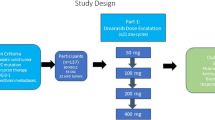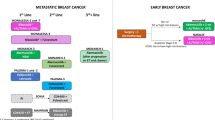Abstract
Purpose
We have studied the interaction of paclitaxel (Taxol) and radiation in V79 cells and human lymphoblasts with special emphasis on cell cycle effects and the role of p53.
Material and Methods
V79 cells in log- and plateau-phase and human lymphoblasts (p53wt TK6 and p53mut WTK1) were used. Paclitaxel was given for 2 hours. Survival was determined using clonogenic assays. Cell cycle analysis was done using DNA flow cytometry.
Results
In V79 cells there was a dose dependent delay of colony formation after paclitaxel. The LD50 was about 0.4 μM with a 2-hour exposure. In exponentially growing cells, there was an accumulation of 40% of cells in G2/M 6 hours after paclitaxel. The dose modification factor was about 3.9 when radiation was given 6 hours after 0.3 μM paclitaxel for 2 hours. Synchronization experiments using serum starvation and induction showed that synchronization was not sufficient to induce a comparable dose modification factor. Human lymphoblasts with mutated p53 (WTK1, LD50=75 μM) were more resistant to paclitaxel than wild type p53 cells (TK6, LD50=25 μM).
Conclusion
The radiosensitization induced by paclitaxel was critically dependent on the timing of irradiation and chemotherapy, although synchronization alone was not sufficient to explain the dose modification. Lymphoblasts with mutated p53 were less sensitive than wild type p53 cells.
Zusammenfassung
Ziel
Wir untersuchten die Interaktion von Paclitaxel (Taxol) und Bestrahlung in V79-Zellen und human en Lymphoblasten unter besonderer Berticksichtigung der Zellzykluseffekte und der Rolle von p53.
Material und Methodik
V79-Zellen in Exponential- und Plateauphase und humane Lymphoblasten (p53wt TK6 und p53mut WTK1) wurden benutzt. Paclitaxel wurde jeweils für zwei Stunden gegeben. Das zelluläre Überleben wurde mit klonogenen Assays bestimmt. Die Zellzyklusanalysen wurden mit der DNA-Flußzytometrie durchgeführt.
Ergebnisse
Bei V79-Zellen wurde eine dosisabhängige Verzögerung der Koloniebildung beobachtet. Die LD50 lag nach einer Zwei-Stunden-Exposition bei 0,4 μM. Bei exponentiell wachsenden Zellen kam es zu einer Akkumulation von 40% der Zellen in der G2/M-Phase sechs Stunden nach Paclitaxel-Gabe. Der Dosismodifikationsfaktor lag bei 3,9, wenn sechs Stunden nach Applikation von 0,3 μM Paclitaxel bestrahlt wurde. Die Synchronisationsexperimente mit Serumentzug und -induktion zeigten, daß die Synchronisation allein nicht ausreichte, einen vergleichbaren Effekt zu erzielen. Die humanen Lymphoblasten mit mutiertem p53 (WTK1, LD50=75 μM) waren resistenter für Paclitaxel als die p53-Wildtypzellen (TK6, LD50=25 μM).
Schlußfolgerung
Die Radiosensibilisierung durch Paclitaxel hängt ganz wesentlich von der zeitlichen Abfolge der Bestrahlung und der Chemotherapie ab, obwohl die Synchronisation allein nicht ausreicht, urn den Dosismodifikationsfaktor zu erklären, Lymphoblasten mit mutiertem p53 waren weniger empfindlich als p53-Wildtypzellen.
Similar content being viewed by others
References
Chaung W, Mi U, Boorstein RJ. The p53 status of chinese hamster V79 cells frequently used for studies on DNA damage and DNA repair. Nucl Acids Res 1997;25:992–4.
Cross SM, Sanchez CA, Morgan CA, et al. A p53-dependent mouse spindle checkpoint. Science 1995;267:1353–6.
Gupta N, Hu U, Deen DF. Cytotoxicity and cell-cycle effects of paclitaxel when used as a single agent and in combination with ionizing radiation. Int J Radiat Oncol Biol Phys 1997;37:885–95.
Jacks T, Weinberg RA. Cell-cycle control and its watchmen. Nature 1996;381:643–4.
Levy JL, Virolainen M, Defendi V. Human lymphoblastoid lines from lymph node and spleen. Cancer 1968;22:517–24.
Liebman J, Cook JA, Fisher J, et al. Changes in radiation survival curve parameters in human tumor and rodent cells exposed to Paclitaxel (Taxol). Int J Radiat Oncol Biol Phys 1994;29:559–64.
Little JB, Nagasawa H, Keng PC, et al. Absence of radiation-induced G1 arrest in two closely related human lymphoblastoid cell lines that differ in p53 status. J Biol Chem 1995;270:11033–6.
Lohr F, Hof H, Weber KJ, et al. X-ray induced changes in immunostaining of proliferating cell nuclear antigen (PCNA) in V79 Chinese hamster fibroblasts. Strahlenther Onkol 1998;174:575–9.
Mason KA, Milas L, Peters LJ. Effect of paclitaxel (Taxol) alone and in combination with radiation on the gastrointestinal mucosa. Int J Radiat Oncol Biol Phys 1995;32:1381–9.
Milas L, Hunter NR, Kurdoglu B, et al. Kinetics of mitotic arrest and apoptosis in murine mammary and ovarian tumors treated with taxol. Cancer Chemother Pharmacol 1995;35:297–303.
Milas L, Hunter NR, Mason KA, et al. Enhancement of tumor radioresponse of a murine mammary carcinoma by paclitaxel. Cancer Res 1994;54:3506–10.
Milross CG, Mason KA, Hunter NR, et al. Relationship of mitotic arrest and apoptosis to antitumor effect of paclitaxel. J Natl Cancer Inst 1996;88:1308–14.
Plasswilm L, Cordes N, Fietkau R, et al. Cytotoxicity of fractionated paclitaxel (Taxol) administration in vitro. Strahlenther Onkol 1998;174:37–42.
Plasswilm L, Cordes N, Sauer R. Schedule-dependent interaction of paclitaxel (Taxol) and irradiation in vitro. Radiat Oncol Invest 1998;6:10–7.
Räve-Frank M, Meden H, Jaschke A, et al. The effect of paclitaxel on the radiosensitivity of gynecological tumor cells. Strahlenther Onkol 1997;173:281–6.
Rübe C, Hampel G, Schuck A, et al. Combined effect of Paclitaxel and ionizing radiation. Experimental data of in-vitro and in-vivo models. Strahlenther Onkol 1996;172:Suppl 1:2–5.
Scheffner M, Werness BA, Huibregtse JM, et al. The E6 oncoprotein encoded by human papillomavirus types 16 and 18 promotes degradation of p53. Cell 1990;63:1129–36.
Schiff PB, Fant S, Horwitz SB. Promotion of microtubule assembly in vitro by taxol. Nature 1979;227:665–7.
Waldman T, Lengauer C, Kinzler KW, et al. Uncoupling of S phase and mitosis induced by anticancer agents in cells lacking p21. Nature 1996;381:713–6.
Wan MC, Taylor HL, Wall ME. Plant antitumor agents. VI. The isolation and structure of taxol, a novel antileukemic and antitumor agent from Taxus brevifolia. J Am Chem Soc 1971;93:2325–7.
Wenz F, Azzam EA, Little JB. The response of proliferating cell nuclear antigen (PCNA) to ionizing radiation is p53 dependent. Radiat Res 1998;149:32–40.
Wenz F, Yu Y, Nagasawa H, et al. Lack of uncoupling of S phase and mitosis in p53(−) human lymphoblastoid cell lines after irradiation. Radiat Res 1997;148:129–34.
Yu Y, Li CY, Little JB. Abrogation of p53 function by HPV16 E6 gene delays apoptosis and enhances mutagenesis but does not alter radiosensitivity in TK6 human lymphoblastoid cells. Oncogene 1997;14:1661–7.
Author information
Authors and Affiliations
Corresponding author
Additional information
Paclitaxel was provided by Bristol-Arzneimittel, München/Germany. Human lymphoblasts were a kind gift from Prof. J. B. Little, Harvard School of Public Health, Boston/MA.
Rights and permissions
About this article
Cite this article
Wenz, F., Greiner, S., Germa, F. et al. Radiochemotherapy with paclitaxel: Synchronization effects and the role of p53. Strahlentherapie und Onkologie 175 (Suppl 3), 2–6 (1999). https://doi.org/10.1007/BF03215919
Issue Date:
DOI: https://doi.org/10.1007/BF03215919




